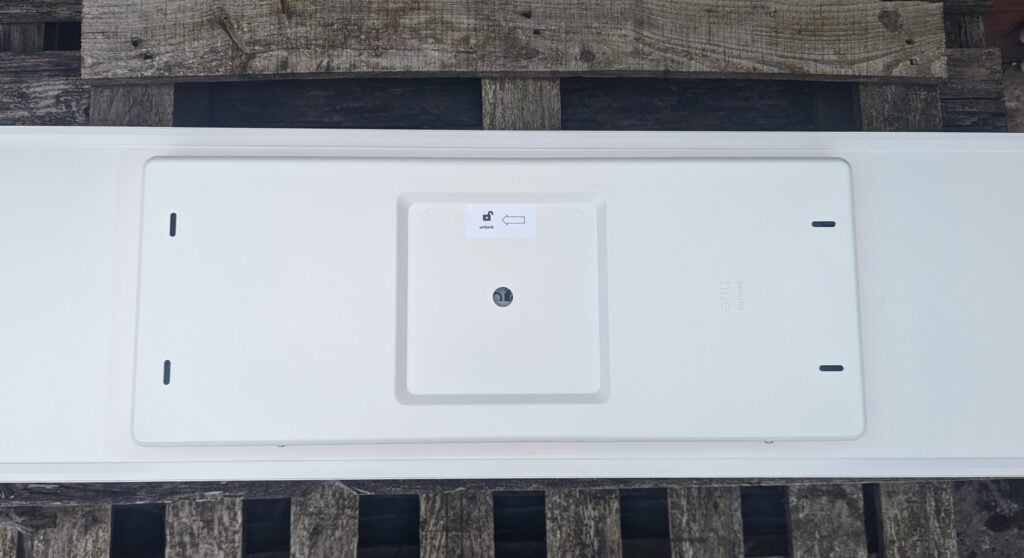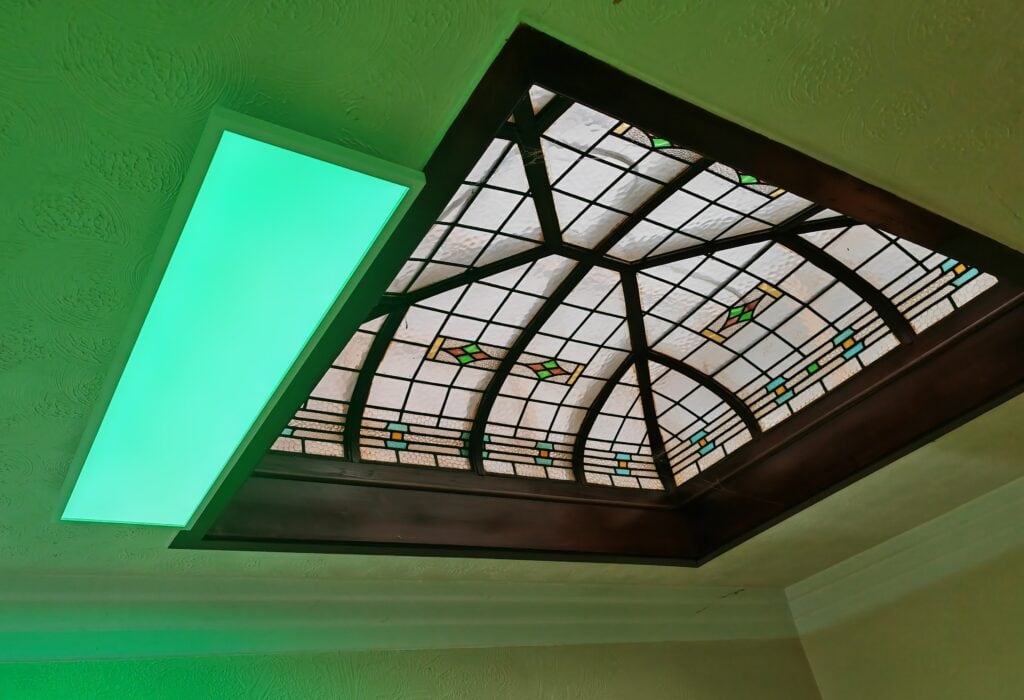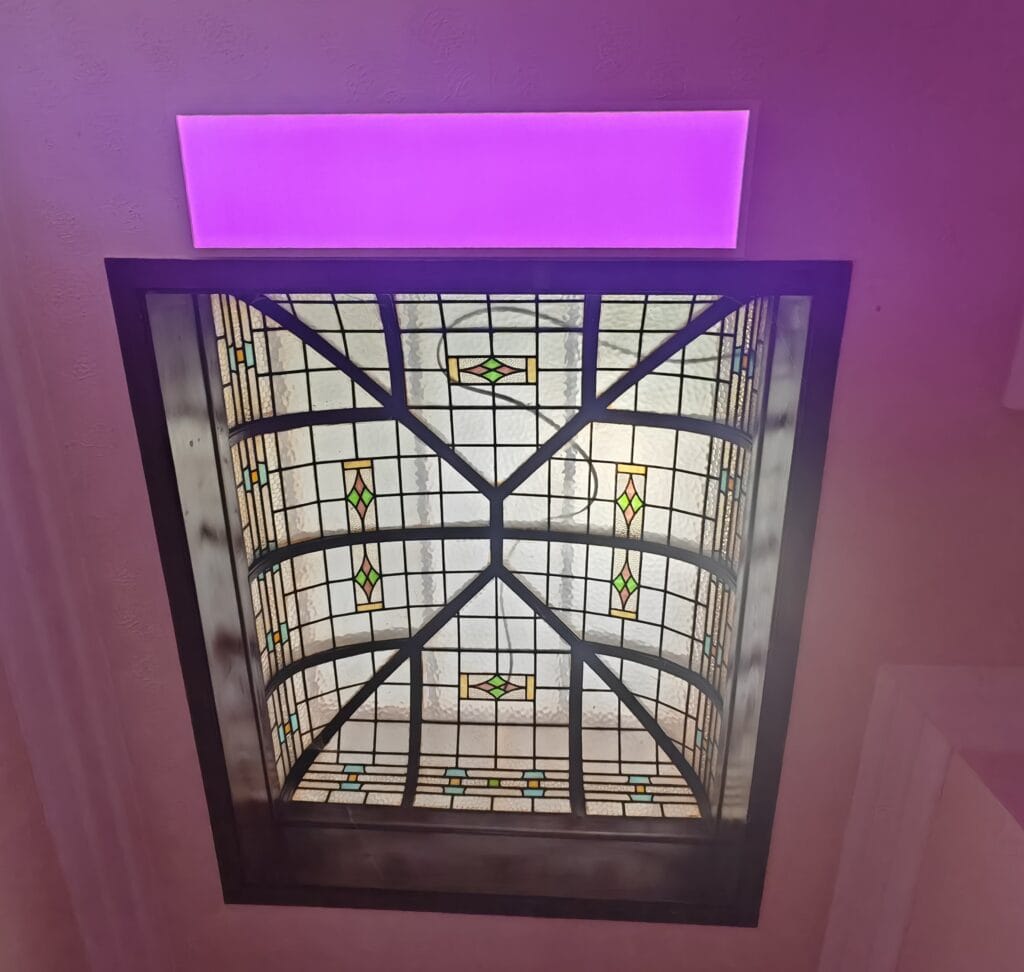Any links to online stores should be assumed to be affiliates. The company or PR agency provides all or most review samples. They have no control over my content, and I provide my honest opinion.
Philips Hue recently extended its range of panel lights with new versions of the Aurelle and Surimu.
These are some of the brightest lights Philips Hue offers, and they are perfect for living areas, hallways and bedrooms.
I was sent the rectangular Surimu panel to review, which is 120cm long and 30cm wide and can output 4,150 lumens, which is more than enough brightness for medium to large rooms.
Due to the brightness, I think these panels end up being an affordable solution as far as Philips Hue goes.
| Preview | Product | Rating | Price | |
|---|---|---|---|---|

| Philips Hue Surimu White and Colour Ambiance Smart Lighting... |
£196.00 | Buy on Amazon |
Other Philips Hue Reviews:
- Philips Hue Bridge Review
- Philips Hue Go Portable Table Lamp Review
- Philips Hue Go 2 White & Colour Ambiance Smart Portable Light Review
- Philips Hue Festavia String Lights Review
- Philips Hue Play HDMI Sync Box Review
- Philips Hue Play Gradient Lightstrip Review
- Philips Hue Signe Gradient Floor Lamp in Oak Review
- Philips Hue Tap Dial Switch Review
Philips Hue Surimu vs Aurelle
Philips Hue Surimu and Aurelle are similar product ranges. The main difference is that the Aurelle range is white ambience, and the Surimu is white and colour ambience.
The new Aurelle products that were launched recently are the same as the existing product range but with a black casing vs white. The Surimu is currently only available with white casings.
Looking at the like-for-like products, the Surimu is a bit brighter at 4,150 lm vs 3,750 lm, but it looks like the Surimu uses more power at 60W vs 39W, though the actual power will vary depending on the brightness and colour used.
Of course, there is a significant price difference. The rectangular Surimu I have reviewed is £295 in comparison to £220 for the equivalent Aurelle.
Available Options
There are four available shapes with the Surimu white and colour ambience range.
- Surimu Small Square Panel
- Lumen output at 4000K – 1,760 lm
- Dimensions (H x L X W) – 4.6 cm x 30cm x 30xm
- Price – £210
- Surimu Round Panel
- Lumen output at 4000K – 2,850 lm
- Dimensions (H x L X W) – 4.7cm x 39.5xm x 39.5cm
- Price – £220
- Surimu Square Panel
- Lumen output at 4000K – 4,150 lm
- Dimensions (H x L X W) – 4.8cm x 60xm x 60cm
- Price – £295
- Surimu Rectangle Panel
- Lumen output at 4000K – 4,150 lm
- Dimensions (H x L X W) – 4.8cm x 120cm x 30cm
- Price – £295
Specification
- Light Specifications:
- Lumens at 4000K: 4150 lumens
- Lumen output at 2700K: 3,350 lm
- Lifetime: 25,000 h
- Light source equivalent: 100 W
- Light Colour: 2000-6500 Hue White Colour Ambiance
- Instant wireless dimming
- Bluetooth and Hue Bridge compatible
- White and colour light
- Dimensions: 4.8cm high x 120cm long x 30cm wide
- Weight: 5.7kg
- Warranty:
- 5 year warranty on the LED module
- 2 year normal warranty
I think the 5-year warranty for the LED modules is important, as the bulbs inside this panel can’t be replaced. So you don’t want to be on the hook for another £300 if something fails after a couple of years.
Design / Installation

The light itself looks a bit boring when you unbox it; it is just a big white panel light, after all. It has a floating design which I think is more to simplify the installation than for aesthetics, and you only really notice it when looking at the light from a far angle.
I didn’t personally install this light. It was a bit big and expensive to risk my incompetent DIY skills on. Thankfully, the review sample arrived when I had an electrician rewiring my upstairs lights, and he kindly installed this for me as well as a Philips Hue wall switch module in my office.
I did look at the installation guide, and it is quite simple. Apart from being physically large, it is no more difficult than any other ceiling light.




You first need to install the bracket to which the panel is attached to. The panel has a built-in cable and carabiner to attach and hang the light on the bracket as you wire it up, avoiding any disastrous drops.
It has been thoughtfully positioned so the light hangs down a bit like a hatch. Once you are done wiring it up, you lift up the panel and slot it into place.
I noticed one review on Amazon stating:
I was able to do it myself. Literally, one man job, took maybe twenty minutes (including removing the old fitting). And I have literally no DIY experience, to be honest, other than building a few sets of Ikea drawers.
It all looked brilliant for the 3 minutes it was up before it came plummeting out of the roof and smashing on the floor. The pack doesn’t include any screws or whatever. You’re just expected to know which ones to use. Turns out I used the wrong ones.
Which sounds like what I would have done if I had tried to install it myself. The light weighs 5.7kg, so you will want to make sure you have the correct anchors and screws to keep it in place.
Philips Hue App & Bridge



I had originally planned to cover the Philips Hue Bridge and its functionality within this review. However, it became quite long, and I felt that it deserved its own dedicated review, which I have published here.
All the Hue indoor lights can be controlled either via Bluetooth or using Zigbee and the Hue Bridge. With Bluetooth, you have basic functionality allowing you to control ten lights that are within your Bluetooth range. You can’t integrate these with any sensors or switches as they all require the Bridge for control.
Bluetooth is a good way to get a taste of the Philips Hue ecosystem, but in my opinion, it is pointless spending the premium price on Hue devices and then not spending £50 on the Bridge to unlock their full potential.
Automation



All smart home ecosystems allow you to set up automation. This is the main selling point of smart home systems and why I think the Bridge is a necessity.
For Hue, you have all the options you need.
For my home, I have my office lights switched on automatically in the morning and switched off in the evening. It is a simple schedule because I do the same thing every day. I have also recently installed the wall switch module, which allows me to turn everything off using my old dumb switch when I leave the office in the evening.
The Surimu panel is located in my upstairs hallway. We live in a corner house with an odd design, so there are no external windows in the hallway. We instead have a glass dome that lets limited light through. Therefore, the hallway is permanently dim and needs the light on most of the time.
This is a perfect scenario for the Philips Hue motion sensors.
I currently have it set up so that during the daytime, the light comes on with the Energise scene, which provides an ultra-bright light, and it will then switch off after three minutes of no motion.
At night, to avoid blinding myself if I go to the toilet, I have the light switch on to night light. This provides a minimal amount of light. It’s enough to allow me to see where I am going and avoids waking me up too much. This will then shut off after one minute.
Later in the year, Hue will be updating the app to support more time slots. So, I will likely use the Energise scene for morning and day time, then a warmer and less bright light for the evening and night light during our sleeping hours.
Performance


Prior to installing the Surimu, I had an industrial-styled pendant with one of the Hue Edison vintage LED bulbs. I think I bought it before they offered the warm-to-cool white bulb, so it was just soft warm white that provided just 550 lm of illumination. It provided adequate light for visibility, but it inevitably meant the hallway was always a bit dark.


With the Surimu installed, it’s like night and day, so to speak. With the Energise scene and full brightness, it is like stepping outside into bright light. The entire hallway is well-illuminated with a consistent spread of light.
Sadly, my hallways are the last part of our home that needs decorating, so the ultra-bright light highlights the awful 20+ year old décor, but it has made me more enthusiastic about finally decorating.

Price and Alternative Options
| Preview | Product | Rating | Price | |
|---|---|---|---|---|

| Philips Hue Surimu White and Colour Ambiance Smart Lighting... |
£196.00 | Buy on Amazon |
The Philips Hue Surimu Rectangle Panel and the large square panel both have an RRP of £295.
At the time of writing, Amazon has the square panel at a slight discount down to around £255.
That’s a lot of money for a ceiling light, but Philips Hue can command premium prices. I actually think it represents good value for money in comparison to alternative Hue products.
If you are happy with white ambience rather than colour, then the Philips Hue Aurelle panels will save you quite a bit. The rectangular Aurelle is £220.
For Hue, the main alternative would be to go for GU10 spotlights. The Philips Hue G10 White and Colour Ambiance is £50 per bulb and only generates 350 lumens. I’d need 12 of those to match the 4150 lumens of this panel!
WiZ recently launched the terribly named Panel Ceiling 36 W Rectangular, which is almost the same dimensions, but the lumen output is 3400 lm and is available for around £120.
The Velora 595x295mm 15.5W 1600lm Zigbee white LED panel is £190.
The Ledvance SMART Zigbee panel is £185 and 2800 lm.
There is also the Müller Licht tint Aris LED panel with the same dimensions and lumens as the Wiz but it is £190.
Overall
The Philips Hue Surimu is undeniably an expensive panel light, as are all Philips Hue products. However, as far as Hue goes, I think this is excellent value for money.
If I had installed GU10 bulbs, it could potentially cost up to £600 for the equivalent lumen output (my maths may be wrong).
Then you also have to factor in that the Hue hub is only designed to support 50 bulbs, so if you use GU10 bulbs, it is very easy to exceed this limit. With the Surimu, it is viewed as one bulb.
Looking at competing brands, the Hue panel is only about £100 more than many other options, yet much brighter.
It is only the Wiz panel that stands out as a good alternative, which is a sub-brand of Signify, the company that owns Philips Hue.
Prior to getting the Surimu, I would never have dreamed of using a panel light in my house, I always felt they give off office suspended ceiling vibes, but now it has been fitted, I love it. So much so I am considering replacing all my other hallway and bedroom ceiling lights with similar Hue products, and I wish I had used these in my kitchen extension rather than the dozens of GU10 spotlights.
Philips Hue Surimu Rectangle Panel Review Rating
Summary
The Philips Hue Surimu is an outstanding light from Philips Hue. The light output is immense, and one panel is more than capable of lighting up a large room. This makes this a perfect alternative to using a large number of GU10 downlights and therefore represents much better value for money than the GU10 colour ambience bulbs that Philips Hue sells.
Overall
98%-
Overall - 98%98%
Pros
- Light output is immense – one panel instead of lots of GU10 downlights
- Easy installation (for a large light)
Cons
- LEDs are built-in and not replaceable
I am James, a UK-based tech enthusiast and the Editor and Owner of Mighty Gadget, which I’ve proudly run since 2007. Passionate about all things technology, my expertise spans from computers and networking to mobile, wearables, and smart home devices.
As a fitness fanatic who loves running and cycling, I also have a keen interest in fitness-related technology, and I take every opportunity to cover this niche on my blog. My diverse interests allow me to bring a unique perspective to tech blogging, merging lifestyle, fitness, and the latest tech trends.
In my academic pursuits, I earned a BSc in Information Systems Design from UCLAN, before advancing my learning with a Master’s Degree in Computing. This advanced study also included Cisco CCNA accreditation, further demonstrating my commitment to understanding and staying ahead of the technology curve.
I’m proud to share that Vuelio has consistently ranked Mighty Gadget as one of the top technology blogs in the UK. With my dedication to technology and drive to share my insights, I aim to continue providing my readers with engaging and informative content.
Last update on 2025-07-18 / Affiliate links / Images from Amazon Product Advertising API







